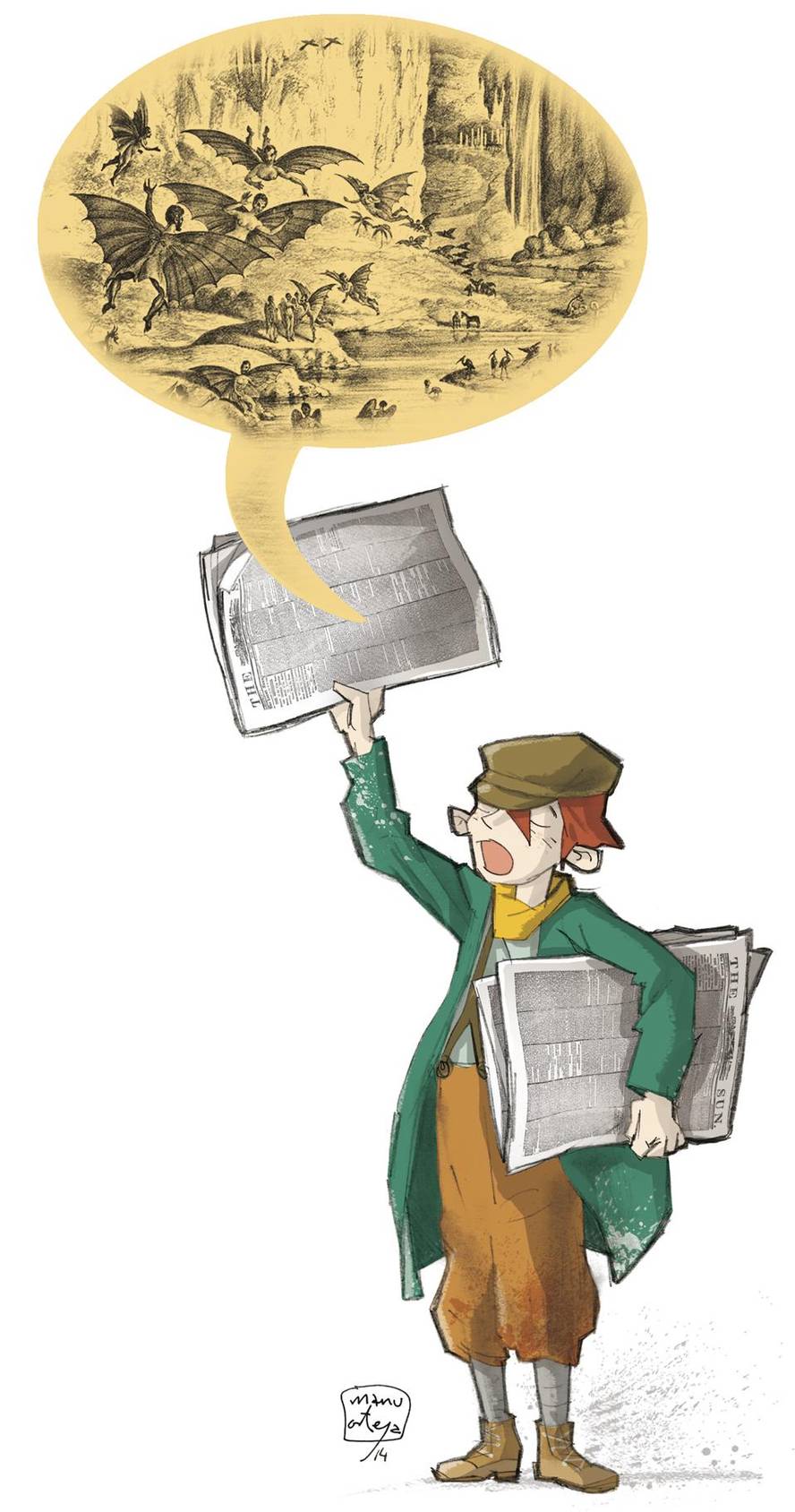The wonderful Moon of John Herschel
John Herschel spent a couple of years researching the sky of the southern hemisphere at the end of Good Hope (South Africa), when one day an American appeared shaking a newspaper in his hand. The American who traveled to Africa in search of an animal for his zoo told him that in that newspaper were narrated "his great astronomical discoveries". Herschel, surprised, thanked him for the gift. And nothing else to read it: "How ridiculous this is! Otoi, what does this mean?"
The American told him, months earlier, that the New York Sun newspaper revealed Herschel's surprising discoveries on the Moon in a series of article 6.
The first news came out on August 21, 1835. It was a brief news brought from Edinburgh Courant: "We have just learned, from the hand of a prestigious editor of the city of [Edinburgh], that Sir John Herschel has made in the Cape of Good Hope some surprising astronomical discoveries through a telescope based on a completely new principle." The six articles that would tell the findings that would follow him.
The first was published on August 25 with a note from the editor: "From today we will publish a series of fragments taken from the new Edinburgh Journal of Science supplement…". This first article spoke of the new telescope created by Herschel. The telescope was huge, but the key was in a new lens called "hydro-oxygen microscope". With this telescope one could study "even the entomology of the Moon, if there were insects on its surface".
In fact, the first article said that he found life on the Moon without further details. And finally, the presentation of the author of the articles. Dr. Andrew Grant, student of the prestigious William Herschel and now assistant to his son at the Cape of Good Hope. Grant wrote this account for Edinburgh Journal of Science as a complement to a more academic text written by Herchel for the Royal Society.
Article 2 included the first establishment of the telescope to the Moon in January 1835. Before the eyes of the researchers appeared the "intense and beautiful representation of the basaltic rocks". They soon realized that the rock was "covered with dark red flowers". They moved the telescope and saw the forests, formed by trees that looked like gigantic cries, and "bright white sand beaches, surrounded apparently with steep green marble rocks and shiny lilac tone needles and pyramids." Afterwards, a valley surrounded by hills of crystallized "pure bermilones", full of waterfalls. And in this valley groups of animals similar to the Bisontes. They, like many other animals that would later be found, had a dark appendix to protect their eyes "from the extreme luminosity and darkness they had periodically on that side of the Moon." They also saw a bluish, one-branch goat and a strange, spherical amphibious being, spinning at high speed on a bowling beach.
Article 3 mentions 38 tree species, twice as many plants, nine mammals and five sheep. And the first signs of intelligence: bipedal castors. These curious castors walked on two legs and carried their offspring in arms. They lived in booths, "better built than many tribes of savages"; and, as the smoke coming out of them suggested, they also dominated the use of fire.
In the room human beings were found inside a ring of red hill. "The body was covered with short, shiny hairs, with the exception of the face, with wings on the back." They were called "vespertilium-homo, or man-bat human". They seemed to speak to each other, so they concluded they were "smart animals." On the other hand, “some of his games would make him fit from the point of view of cleaning the Earth.”
In the following article, he realized a series of mysterious temples apparently abandoned. And in the last, it was said that near the temples found a more evolved evening homo, "higher than the previous ones, of lighter color and, in all aspects, a better variety of the race". The day on which they collected their fruits, flew, bathed and chattered was "super beautiful and in our eyes it seemed as friendly as the angels represented by the best painter".
Herschel laughs at hearing about it all. "I suspect that the results of the telescope observations made at the Cape of Good Hope will be very humble, at least next to what this American story attributes to me! ", said smiling.
But Herschel's good humor did not last long. And that is, those news spread all over the world and were provoking a great upheaval. In August 1836 Herschel wrote to the editor of the London magazine Athenaeum: "...it is time to deny my knowledge or my participation in relation to those disparates published in the name of the discoveries that have been attributed to me". And a year later he wrote to his aunt Caroline: "I have been upset everywhere at the expense of this fun Moon fraud, in English, French, Italian and German!"
The New York Sun did not immediately accept the fraud. Although he began to suspect that everything could be invented, the newspaper remained firm. For example, the editor of the New York Herald (Sun's main rival), James Gordon Benette, criticized from the beginning that everything was invented. And on August 31, 1835, he gave a clarification: The source referred to by Sun, Edinburgh Journal of Science, was closed two years earlier, so it was impossible for those findings to be published there. And Benett advanced that the true author of these texts was Richard Adams Locke. Sun continued without confessing anything and Locke will deny it.
In the autumn of 1836, Locke left on Sun and begins in New Age. Shortly after arriving at the new newspaper, he signed an article written as follows: "The author of the Moon Fraud".
"This entry #CultureCientífico 2. Participate in the festival"








